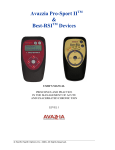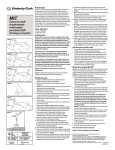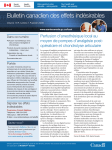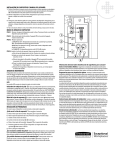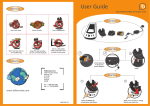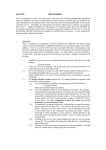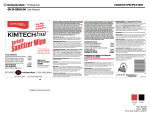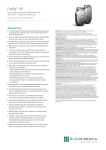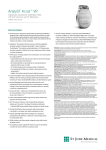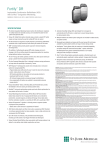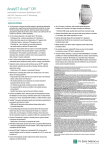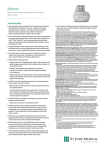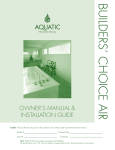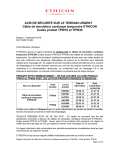Download ON-Q* Pump with Select-A-Flow* Variable Rate
Transcript
Instructions For Use ON-Q * Pump with Select-A-Flow * Variable Rate Controller X ml/Y min M A N U F A C T U R E D B Y: Kimberly-Clark 1400 Holcomb Bridge Road Roswell, GA 30076 USA Kimberly-Clark N.V. Da Vincilaan 1 1935 Zaventem, Belgium ON-Q* Pump with Select-A-Flow* Variable Rate Controller Instructions For Use IMPORTANT INFORMATION Please read the entire document before operating the ON-Q* device. Follow all instructions carefully to ensure the safety of patient and/or user. USER INFORMATION • For 24-hour Product Support, call 800-444-2728 or +1-949-923-2400 (English only). • Visit www.iflo.com or contact your sales representative for the latest product information and Technical Bulletins, including but not limited to: • ON-Q* with Select-A-Flow*, Drug Dosing Information Technical Bulletin • Use of ON-Q* Pump in Magnetic Resonance (MR) environment • Latex Sensitivity • Continuous Infusion in Pediatric Patients • Use of ON-Q* Pump in Hand and Foot Surgery Volume and Flow Rate Selection • What We Know About Chondrolysis Today • Use of ON-Q* with Perioperative Autologous Blood Transfusion Systems • USP 797 • Effect of Storage Times on Flow Rate on Pre-filled ON-Q* Elastomeric Pumps • Patient Guidelines • • • • • WARNING Flow rate is adjustable. Medication dosage should be based on maximum flow rate. To reduce potential adverse events: • Medication dosing should be based on the maximum flow rate (7 or 14 ml/hr). • The amount of medication over the therapeutic period and delivery time can vary by as much as 20%. Take this variance into consideration when determining medication delivery. • Regardless of the prescribed flow rate, only fill the pump with medication dosage that is appropriate to administer at the maximum flow rate. • Due to risk of ischemic injury, vasoconstrictors such as epinephrine are not recommended for continuous infusions for the following routes of administration: • • intraoperative site, perineural and percutaneous (excluding epidural). Medications or fluids must be administered per instructions provided by the drug manufacturer. Physician is responsible for prescribing drug based on each patient’s clinical status (such as age, body weight, disease state of patient, concomitant medications, etc.). There is no alarm or alert when flow interruption occurs, therefore, life-supporting medications whose usage may cause serious injury or death due to stoppage or under-delivery are not recommended for infusion with the ON-Q* device. There is no indicator of pump infusion status, therefore, use caution where over-delivery of medications could result in serious injury or death. Epidural infusion of analgesics is limited to uses of indwelling catheters specifically designed for epidural delivery. To prevent infusion of drugs not indicated for epidural use, do not use IV set with additive ports. It is strongly recommended that devices used for administration of medication via epidural routes be clearly differentiated from all other infusion devices. To avoid complications, use the lowest flow rate, volume and drug concentration required to produce the desired result. In particular: • Avoid placing the catheter in the distal end of extremities (such as fingers, toes, nose, ears, penis, etc.) where fluid may build up as this may lead to ischemic injury or necrosis. • Avoid placing the catheter in joint spaces. Although there is no definitive established causal relationship, some literature has shown a possible association between continuous intra-articular infusions (particularly with bupivacaine) and the subsequent development of chondrolysis. • Avoid tight wrappings which can limit blood supply or fluid diffusion. It is the responsibility of the healthcare provider to ensure patient is educated on the proper use of the system. It is the responsibility of the healthcare provider to modify Patient Guidelines provided with the pump as appropriate for your patients’ clinical status and medication prescribed. 1 CAUTION • • Do not use if package is open, damaged or a protector cap is missing. Single use only. Do not resterilize, refill or reuse. Reuse of the device could result in the following risks: • Improper functioning of the device (i.e., inaccurate flow rate) • Increased risk of infection • Occlusion of the device (i.e., impedes or stops infusion) • The pump is sterile and non-pyrogenic. • Product uses Di (2-ethylhexyl) phthalate (DEHP) plasticized PVC: • DEHP is a commonly used plasticizer in medical devices. There is no conclusive scientific evidence to date that exposure to DEHP has a harmful effect on humans. However, the risk and benefit of using medical devices with DEHP for pregnant women, breastfeeding mothers, infants and children should be evaluated prior to use. • Certain solutions may be incompatible with the PVC material used in the administration set. Consult drug package insert and other available sources of information for a more thorough understanding of possible incompatibility problems. • Do not underfill pump. Underfilling the pump may significantly increase the flow rate. • Do not exceed maximum fill volume. (Table 1) • The fill volume and infusion rate are labeled on the fill port. • Flow rate is unpredictable if it is dialed between rate settings. • Clamp is provided to stop the infusion. Do not remove or break clamp. Do not use clamp as an intermittent delivery device. • Roll tubing between fingers to promote flow if clamped for extended time. • Avoid contact of cleansing agents (like soap and alcohol) with the filter because leakage may occur from the air eliminating vent. • Do not tape over filter(s) as this could block the air vent and impede the infusion. • Do not immerse the pump in water. Take care to protect the pump during any activities, which could cause the pump and filter to get wet, such as showering. • In the event of any leakage from the pump or administration set, close tubing clamp. Replace pump if necessary. • Do not discard the pump and contact I-Flow* for product return instructions. 2 • Do not add unvented filter to end of the administration set as this may impede or stop the flow rate. • Flow rates may vary due to: Fill volume • Filling the pump less than the labeled volume results in faster flow rate. • Filling the pump greater than the labeled results in slower flow rate. • Viscosity and/or drug concentration. • Pump position - position the pump at approximately the same level as the catheter site: • Positioning the pump above this level increases flow rate. • Positioning the pump below this level decreases flow rate. Temperature • The Select-A-Flow* device should be worn outside clothing and kept at room temperature. • To ensure flow rate accuracy, do not place heat or cold therapy in close proximity to the flow controller. • Temperature will affect solution viscosity, resulting in faster or slower flow rate. • Select-A-Flow* device have been calibrated using Normal Saline (NS) as the diluent and room temperature (22°C, 72°F) as the operating environment. Flow rate will increase approximately 1.4% per 1°F/0.6°C increase in temperature and will decrease approximately 1.4% per 1°F/0.6°C decrease in temperature. • If refrigerated, allow pump to reach room temperature before using. • It may take approximately 8-18 hours for a pump to reach room temperature. (See table below) Fill Volume (ml) 100 200 270 400 600 Refrigerator to Room Temp (hr) 8 12 12 15 18 Storage • Storage of a filled ON-Q* Pump for more than 8 hours prior to starting infusion may result in a slower flow rate. External pressure • External pressure such as squeezing or laying on the pump increases flow rate. INDICATIONS FOR USE • The ON-Q* pump is intended to provide continuous delivery of medication (such as local anesthetics) to or around surgical wound sites and/or close proximity to nerves for preoperative, perioperative and postoperative regional anesthesia and/or pain management. Routes of administration include: intraoperative site, perineural, percutaneous and epidural. • ON-Q* pump is indicated to significantly decrease pain and narcotic use when used to deliver local anesthetics to or around surgical wound sites, or close proximity to nerves, when compared to narcotic only pain management. SELECT-A-FLOW* DEVICE DESCRIPTION Select-A-Flow* device is a flow controller that allows the user to adjust the infusion rate by turning the rate-changing key on the device. The flow rate is within a predetermined range and is designated on each device. Figure 2 1 2 3 CONTRAINDICATIONS • ON-Q* Pump is not intended for blood, blood products, lipids, fat emulsions, or Total Parenteral Nutrition (TPN). • ON-Q* Pump is not intended for intravascular delivery. DESCRIPTION OF DEVICE Figure 1 The ON-Q* Pump with Select-A-Flow* device incorporates a controller that allows the user to adjust the infusion rate. 1 Fill Port 2 ON-Q* Pump 3 Clamp 4 Air-Eliminating Filter 5 Select-A-Flow* Variable Rate Controller 6 Flow Rate Dial 7 Rate-Changing Key 8 Lockable Cover Figure 1 WARNING: Do not rely on the Select-A-Flow* key or tie-wrap to prevent patient tampering. 1 Select-A-Flow* device is available in two flow rate ranges and distinquished by color on the face of device: 2 3 4 8 TO DISCOURAGE TAMPERING: (Figure 2) 1. Remove the rate-changing key from the dial by pulling the key straight out. Put the key in a safe place for later use, e.g., attached to a key ring. 2. Close the cover over the Select-A-Flow* Variable Rate Controller. 3. For increased tamper resistance, the cover may be locked to the Select-A-Flow* Variable Rate Controller using the tie-wrap. Note: If desired, the cover may also be removed from the Select-A-Flow* device by fully opening the cover and then pulling straight up on the plastic feet at the bottom of the cover. 5 Green (1-7 ml/hr) • Flow rate dial - 1, 2, 3, 4, 5, 6, 7 ml/hr White (2-14 ml/hr) • Flow rate dial - 2, 4, 6, 8, 10, 12, 14 ml/hr 7 6 3 INSTRUCTIONS FOR USE WARNING: Flow rate is adjustable. Medication dosage should be based on maximum flow rate. Pump is pre-set at 7 ml/hr or 14 ml/hr (depending on model). Use Aseptic Technique FILLING THE ON-Q* PUMP: (Figure 3) Note: Follow hospital protocols and applicable regulations for filling pump. 1. Close clamp. 2. Uncap the fill port. 3. Attach filled syringe to fill port. Invert pump as shown. 4. Grasp syringe with both hands. 5. Push down on plunger continuously until volume is dispensed. Do not handle pump while filling, as the syringe tip may break. Repeat as necessary. Syringe accuracy is ±4%. Note: Filling Extension Sets are provided with larger pumps (see product insert). 6. Remove filling device from fill port 7. Replace fill port cap. Label with appropriate pharmaceutical and patient information. Figure 3 Table 2: 24-Hour Dosing Reference Select-A-Flow* Model Drug Concentration (mg) 0.2% 0.25% 0.5% 7 ml/hr Max Flow Rate 336 420 840 14 ml/hr Max Flow Rate 672 840 1680 Formula: ml/hr x % drug concentration x 10 x 24 hr = 24 hour dose (mg) CAUTION: Calculations based on the labeled flow rate. Flow rate accuracy varies. PRIMING THE ADMINISTRATION SET Use Aseptic Technique Note: Select-A-Flow* device is packaged with the flow rate at the highest setting to minimize priming time. FILL VOLUME CAUTION: Do not underfill pump. Underfilling the pump may significantly increase the flow rate. Do not exceed maximum fill volume. (Table 1) Table 1: Fill Volume (ml) 4 Fill Volume 100 200 270 400 600 Max Fill Volume 125 335 335 550 750 Retained Volume ≤5 ≤11 ≤11 ≤16 ≤23 1. Open the plastic cover of the Select-A-Flow* device 2. To begin priming the Select-A-Flow* device, ensure highest flow rate setting is selected. • Make sure the selected flow rate is aligned below the ml/hr x mark. • The tactile feel will allow the user to ensure selected flow rate is set. 3. Open the clamp and remove tubing cap to begin priming. 4. When all air has been removed from the entire tubing and fluid is observed at end of luer lock, the administration set is primed. 5. Turn the dial back to ø, off position and close the clamp. 6. Replace tubing cap until ready for use. STARTING INFUSION CHANGING THE FLOW RATE DURING AN INFUSION Use Aseptic Technique 1. Connect tubing to patient’s catheter. Make sure connection is secure. 2. Select the appropriate flow rate by turning the dial on the Select-A-Flow* device until the flow rate setting is aligned with the ml/hr x mark on the face of the SelectA-Flow* device (Figure 4). • The orientation of the rate-changing key does not indicate the flow rate selection. • The tactile feel will allow the user to ensure selected flow rate is set. Figure 4 Examples of flow rate settings 3 ml/hr 6 ml/hr 1. Insert the rate-changing key into the dial of the Select-A-Flow* device. 2. Turn the dial until the new flow rate is selected. Make sure the selected flow rate setting is aligned with the ml/hr x mark on the face of the Select-A-Flow* device. The tactile feel will allow the user to ensure selected flow rate is set. 3. Remove the key from the dial and put in a safe place for later DURING THE INFUSION: • A change in appearance and size of the pump may not be evident during the first 24 hours after start of infusion. • As medication is delivered, the pump will gradually become smaller. • Make sure: • Clamp is open • There are no kinks in the tubing • Filter vent is not taped or covered • Heat, ice or cold therapy is placed away from the flow controller END OF INFUSION: • Infusion is complete when pump is no longer inflated. • Close clamp, disconnect and dispose of the pump according to your institution’s protocol. Note: If pump did not perform as expected do not CAUTION: Dial must be aligned with number and ▼ to ensure accurate flow rate. Do not dial between numbers. Flow rate is unpredictable if dialed between numbers (Figure 5). Figure 5 Incorrect alignment discard. Contact I-Flow* for product return instructions: [email protected]. Correct alignment 3. Open clamp. 5 TECHNICAL SPECIFICATIONS DELIVERY ACCURACY: When filled to the labeled volume , Select-A-Flow* device delivery accuracy is ±20% of the labeled rates when infusion is started 0-8 hours after fill and delivering normal saline as a diluent at 22°C/72°F. TYPICAL FLOW CURVE Figure 6 Flow Rate Typical Flow Curve Nominal Percent Delivery Time 100% The flow rate may be higher or lower at the beginning and end of the infusion (Figure 6). NOTE: Latex is not in fluid pathway or in contact with human. Refer to ON-Q* Pump Latex Sensitivity Technical Bulletin at www.iflo.com. STORAGE CONDITIONS Store under general warehouse conditions. Protect from light sources and heat. Keep dry. Rx only = CAUTION: Federal (U.S.A.) law restricts this device to sale by or on the order of a physician. Additional U.S and Foreign Patents may be issued and/or pending. *Registered Trademark or Trademark of Kimberly-Clark Worldwide, Inc. or its affiliates. © 2010 KCWW. All Rights Reserved. For more information, please call +1.949.923.2400 • 1.800.448.3569 (English only) or visit www.iflo.com for the latest product information and Technical Bulletins. 6 7 8 For Customer Service please call: +1.949.923.2400 • 1.800.448.3569 English only iflo.com M A N U F A C T U R E D B Y: Kimberly-Clark 1400 Holcomb Bridge Road Roswell, GA 30076 USA Kimberly-Clark N.V. Da Vincilaan 1 1935 Zaventem, Belgium A K I M B E R LY- C L A R K H E A LT H C A R E C O M PA N Y Distributed in the U.S. by I-Flow, LLC, located in USA. I-Flow* is a Kimberly-Clark Health Care Company. *Registered Trademark or Trademark of Kimberly-Clark Worldwide, Inc. or its affiliates. © 2010 KCWW. All Rights Reserved. 14-60-613-0-04 70159789 2014-03-12












